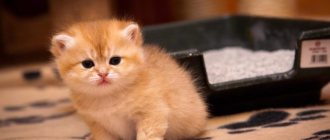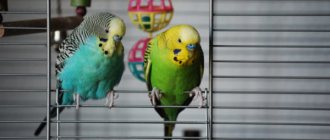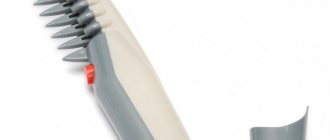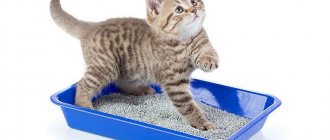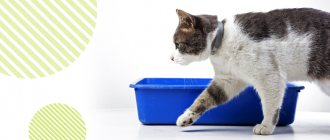Rabbits are not only meat and fluff, but also wonderful pets. They are very sweet and friendly, willingly get along with other animals, and quickly find a common language with children. Many who want to have an ornamental pet believe that the main thing is to buy the animal a cage and feed it. But in order for the eared creature to feel comfortable, grow healthy and playful, it will need proper daily care.
Animals are living beings who, in addition to the need for food, have many other physiological needs. One of these is defecation. Prospective breeders should understand that in addition to cleaning up feces, they will need to spend time training the animal to defecate in a certain place. If you don’t train rabbits, they will start crap everywhere in the apartment.
How to choose a toilet
You need to choose the tray correctly, otherwise your pet may refuse to go there. The size of the toilet should be comfortable so as not to oppress the animal. If he feels cramped, he will find another place to fuse his needs. The edges should be smooth to eliminate the chance of injury. A healthy pet is very active and can easily get hurt.
A plastic cat litter box is often chosen for a rabbit. It is quite voluminous and has smooth sides. Particularly suitable for dwarf breeds. Some trays have rods; it is better to remove them so as not to create discomfort for delicate paw pads.
Any vessel of suitable size can be used as a toilet. It should be more or less warm. Sometimes metal basins are used, in which case more filler is needed so that the animal does not feel the cold.
You can train a rabbit to use the toilet in an apartment only if it is comfortable there.
Which tray to choose
How quickly you can train your pet to use the toilet depends on how correctly the tray is selected. It should be comfortable and convenient. The animal must not only fit completely in it, but also be able to move around.
How to toilet train a Chihuahua: diaper or litter box
There are two types of trays you can purchase at a pet store:
- corner - it is best suited for cells of small size and rectangular shape;
- rectangular - for indoor fences or spacious cages.
The design of the tray should include a mesh and a removable grid. Externally, the device resembles a cat litter box. Its tasks are to provide the animal with comfort and also ensure the necessary level of hygiene.
Advice! You can use a homemade tray made from plastic containers. It is important that it has low sides that are comfortable for the pet.
The tray should first of all be spacious
Filler selection
Large filler is poured into the purchased tray. If it is sawdust, then only from deciduous trees. They are not harmful and quickly absorb unpleasant odors. Cat litter is designed specifically for cats and is infused with chemicals to kill bacteria and odors. Rabbits are constantly looking for something to chew; getting such chemicals into their mouths can end in disaster.
If sawdust is not available, it can be replaced with hay or straw. As a last resort, use torn colorless paper. There should be no inscriptions or other colors on it.
Tray in the apartment
Decorative rabbits walk around the house during the day, only in the evening they are locked in a cage, and even then not always. It is important to potty train your rabbit in an apartment so that it knows where to go. If the tray is placed very close in the cage, then the house is very large, it will be more difficult to train to the toilet. In this case, you will need several devices; they should be in every room. Mostly placed in corners. If possible, observe your pet which place he chooses for himself. Most likely, this will be a corner or area near the wall. Be careful, if you miss a moment, you will have to do unpleasant cleaning.
Is it possible to toilet train a rabbit?
It is not only possible, but also necessary, to potty train a rabbit living in an apartment. Before you begin training, you need to find out some information about the life of long-eared animals in the wild. In their natural habitat, rabbits live in burrows and do not create a special place for a toilet in them. If they need to relieve themselves, they simply leave the confines of their home.
Once in a home environment, a rabbit perceives its cage or enclosure as a burrow. Your apartment for him is a space outside the home. Therefore, it is not surprising that he marks his territory around the hole. Based on this, you need to properly work out a plan for potty training your pet.
Did you know? A rabbit weighing 2 kg can drink the same amount of water as a dog weighing 10 kg.
Training procedure
After choosing the right place, let's return to the most important thing, training the rabbit to use a tray in a cage and apartment. First, let's try to train a decorative animal. Come up with a command that will signal your pet to go to the place you have designated. Once you have installed the toilet, show it to your rabbit and repeat the command several times.
Let's be honest, he won't understand anything the first time. Let's move on to training. Keep a close eye on your subordinate, wait until he wants to poop. As soon as it begins to take the desired position, carefully pick it up and transfer it to the tray. Point your finger and repeat the command. After a few lessons, the rabbit will understand the lesson.
Not everyone has the time and desire to run after their pet and wait until it wants to poop. To train a rabbit to go to the toilet in one place, you need to collect its poop and take it there. Then take the animal and let it smell a new place. We do the same with urine, transferring some of the aroma to the tray. Training takes place quickly; in a few procedures, the rabbit will learn to go to the toilet in the apartment. It is very important to completely remove the smell left in all other places.
Suitable age for training
Before starting training, it is important to choose the right age of the animal so that toilet training is more successful. Little, unintelligent rabbits and adults who are not accustomed to going to one place will most likely not understand what is required of them.
It is best to train a decorative rabbit at 40-50 days, that is, just a few days after it was taken from its mother. At this time, the rabbits have already grown enough and are capable of learning, but have not yet acquired stable habits.
The maximum age for dwarf rabbits suitable for training is 3-4 months, after which they enter puberty, their character and behavior change, and it becomes much more difficult to train them. Therefore, it will be problematic to train a pet older than six months.
The rabbit refuses to go to the litter box
Training does not always bring the desired result. If after two weeks you still haven’t been able to train him to the tray, you need to look for the source of the problem. There are several common reasons:
- During the mating season, an uncastrated rabbit is extremely difficult to tame.
- Inconvenient or too small tray. Pay attention to the placement of the animal on it; there should be some space left on all sides. With dwarf rabbits it is easier in this regard.
- The problem is in the filler, it gives off a bad smell.
- The space inside the cage is poorly organized and the pet is uncomfortable.
- If a trained fluffy refuses, he experiences stress. Just give it some time to calm down.
Things to know
It is very important to be patient and meek. Any aggression or shouting will nullify all efforts. The animal will begin to fear and avoid you. In such a state, no learning will be successful. It is much better to reward the right actions. When your pet is done in the potty, you can give him a treat and stroke his fur.
Decorative rabbits are very emotional and sensitive. Experienced owners know how to train a rabbit to use a litter tray and what is needed for this. They stock up on patience in advance.
If your rabbit sleeps in a litter box, the problem is in the bedding. She is too dirty or inappropriate to avoid contact and he lies down where she is not. There may be other reasons; to find out, observe your pet’s behavior.
Is it possible to shape toilet behavior in rabbits?
The life of animals is mainly determined by instincts. Wild rabbits live in burrows. These are very clean animals. Adult animals do not crap in their home. They endure, get out of their holes and move a few meters away.
Domestic rabbits behave the same way, even if they have never gone outside. This is genetic memory. Therefore, pets, as a rule, “misbehave” not out of harm or stupidity, but simply do not understand the differences between a carpet or sofa and a special tray.
However, there is no need to give up on an adult animal. The older the animal, the cleaner it is. Little rabbits do not think about self-control, but gradually, by three months, everything changes.
At the age of several months, animals begin to mark their territory. This is not just going to the toilet, but sexual behavior or a “struggle for power.”
Some useful tips
We found out whether it is possible to train a rabbit to use a litter tray and how to do it. For faster results, we recommend that you familiarize yourself with several rules and tips.
Before buying an animal, find out where the previous owner had a tray. Ask for dirty litter as a gift, you will need it for training. By placing the toilet in a similar place, the pet will feel a familiar smell there. In the future he will use the pot for its intended purpose.
Clean the tray and change the litter regularly. At first, leave a small part of the old one for the smell. This will be a hint for your pet. If you do not change the litter for more than a week, the pet will stop going to the installed toilet. The pet will perceive the presence of sawdust next to the pot as an extension of the toilet. It’s better not to let it get to this point.
Even if you train your rabbit to use a litter box, you may still see poop scattered around the cage from time to time. They need to be cleaned regularly. The fact is that the animal can poop while feeding. This is a natural process and should not be scolded for it.
Sometimes a rabbit deliberately does not go to the litter tray and chooses another place for the toilet. To cope with this, it is enough to place another device in a new place. Over time, you can remove the second pot. Castration will help correct this behavior.
